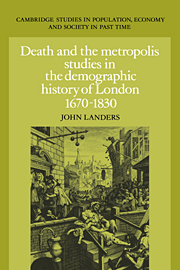Book contents
- Frontmatter
- Contents
- List of figures and maps
- List of tables
- Preface
- Acknowledgements
- Part I EIGHTEENTH-CENTURY LONDON AND ITS VITAL REGIME
- Part II THE LEVEL OF MORTALITY
- Part III DIMENSIONS OF LONDON'S EPIDEMIOLOGICAL REGIME
- Appendices
- 1 The Parish Register sample
- 2 The Autumn diseases and the ‘putrid sore throat’
- 3 Parish boundaries
- 4 Burial seasonality from Parish Registers
- Bibliography
- Index
- Cambridge Studies in Population Economy and Society in Past Time
2 - The Autumn diseases and the ‘putrid sore throat’
Published online by Cambridge University Press: 05 November 2011
- Frontmatter
- Contents
- List of figures and maps
- List of tables
- Preface
- Acknowledgements
- Part I EIGHTEENTH-CENTURY LONDON AND ITS VITAL REGIME
- Part II THE LEVEL OF MORTALITY
- Part III DIMENSIONS OF LONDON'S EPIDEMIOLOGICAL REGIME
- Appendices
- 1 The Parish Register sample
- 2 The Autumn diseases and the ‘putrid sore throat’
- 3 Parish boundaries
- 4 Burial seasonality from Parish Registers
- Bibliography
- Index
- Cambridge Studies in Population Economy and Society in Past Time
Summary
The increased importance of the ‘Autumn diseases’ (see chapter 7) in the seasonality of mortality during the central decades of the eighteenth century coincides with the epidemics of ‘putrid sore throat’ described by a number of contemporary physicians. These appear to have been part of a regional pandemic which affected much of the Atlantic world from its appearance in New England in 1735–7 (Dobson 1989b: 282). As described by Creighton (1894: 698–9) it first struck England late in 1739, but was not associated with severe excess mortality until the outbreak of 1746, after which it continued throughout the 1750s before disappearing in the subsequent decade.
The exact nature of the condition remains obscure, but contemporary descriptions, such as that of Fothergill (quoted in Creighton 1894: 698–9), strongly suggest that it was a form of streptococcal throat infection. This possibility can be investigated to a limited degree using the cause-specific burial totals from the annual Bills of Mortality. Since the streptococci in question are also responsible for puerperal fever (Loudon 1987), the hypothesis would lead us to expect a closer relationship between maternal mortality and fever mortality (the cause of death series whose seasonality seems to have been most affected) during the decades 1730–59 than either before or after.
The results of a principal components analysis carried out on the correlation matrix of cause-specific CMRs (see below) lend some support to this hypothesis.
- Type
- Chapter
- Information
- Death and the MetropolisStudies in the Demographic History of London, 1670–1830, pp. 363 - 364Publisher: Cambridge University PressPrint publication year: 1993



